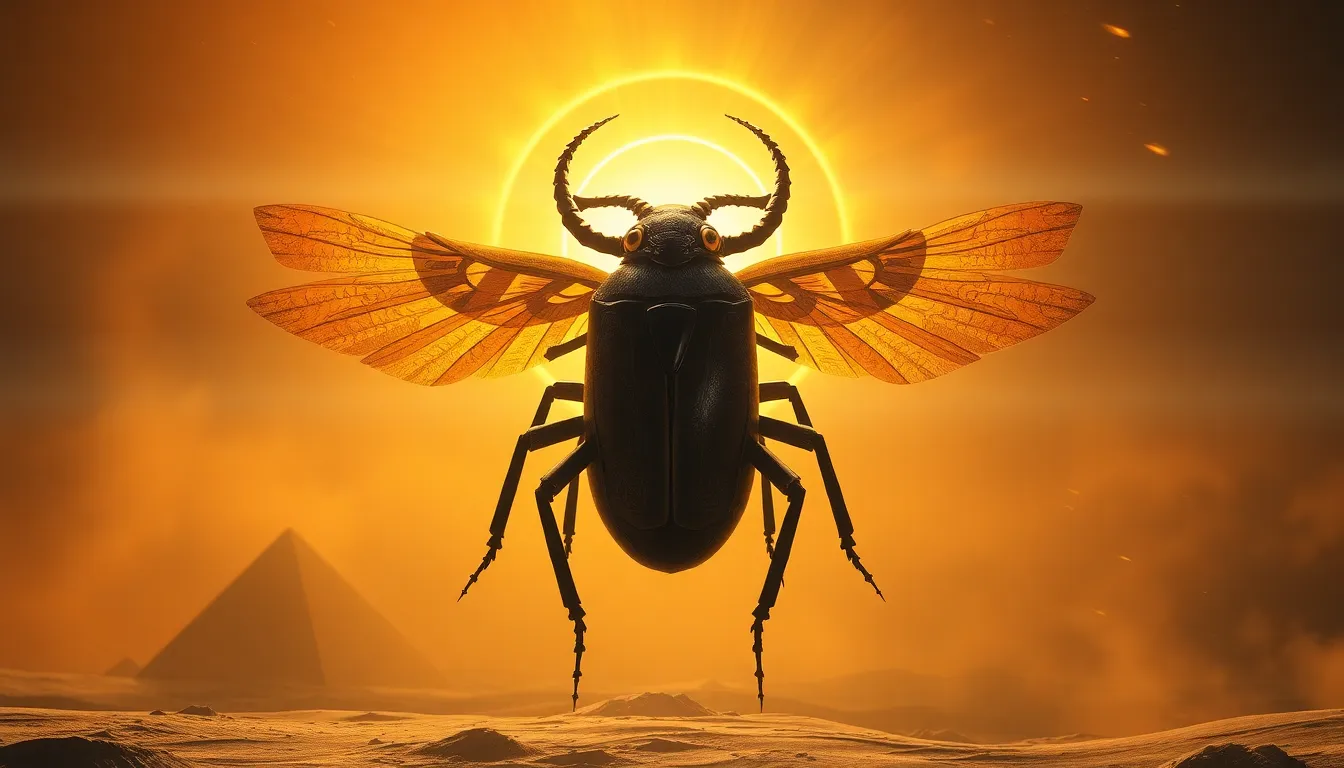The Solar Myth of the Sacred Scarab: Khepri’s Transformation
I. Introduction
Khepri is a prominent deity in ancient Egyptian mythology, often depicted as a scarab beetle or a man with a scarab head. He symbolizes the rising sun and is deeply intertwined with the concept of regeneration and rebirth. The sacred scarab beetle has served as a powerful symbol in Egyptian culture, representing life cycles, protection, and transformation.
This article explores Khepri’s transformation, delving into his significance within the context of Egyptian mythology and the broader implications of his symbolism. We will uncover the mysteries surrounding this vital deity and the sacred scarab’s role in the ancient Egyptian worldview.
II. The Origins of Khepri
Khepri’s origins can be traced back to the early dynastic period of ancient Egypt, where he emerged as a solar deity associated with the morning sun. His name, which means “to become” or “to transform,” reflects his role in the daily renewal of the sun.
In Egyptian mythology, Khepri is closely linked to Ra, the primary sun god. While Ra represents the sun at its zenith, Khepri embodies the sun’s emergence at dawn, symbolizing hope and new beginnings.
The scarab beetle, known scientifically as Scarabaeus sacer, holds significant cultural relevance in ancient Egypt. The beetle’s behavior of rolling balls of dung, which were seen as eggs, led to the belief that it could give birth spontaneously, thus connecting it to themes of creation and regeneration.
III. Symbolism of the Scarab Beetle
The scarab beetle is a powerful symbol of regeneration and rebirth in Egyptian culture. Its lifecycle, which includes transformation from larva to adult, mirrors the cycles of life, death, and rebirth that permeate Egyptian beliefs.
- Regeneration: The scarab’s ability to roll dung balls as a form of nourishment was interpreted as a metaphor for the sun’s ability to rise each day.
- Funerary Practices: Scarabs were commonly placed in tombs as amulets, believed to protect the deceased and ensure their rebirth in the afterlife.
- Cross-Cultural Interpretations: Other cultures, such as the Aztecs and Mayans, also revered beetles, often associating them with creation and the cycle of life.
IV. Khepri’s Daily Cycle
Khepri’s role in the daily cycle of the sun is integral to his mythology. He is depicted as rolling the sun across the sky, much like the scarab rolls its dung ball. This journey represents the passage from night to day, symbolizing renewal and the promise of a new dawn.
As the sun rises, Khepri is responsible for bringing light and warmth to the world, embodying the themes of life and regeneration. The mythological narratives surrounding Khepri often illustrate his struggle against the forces of darkness, emphasizing his role as a protector and a harbinger of life.
V. The Transformation of Khepri
The transformation of Khepri is rich with metaphysical meanings. Each day, Khepri undergoes a metamorphosis as he rises with the sun, symbolizing the eternal cycle of life, death, and rebirth. This transformation is pivotal in understanding Egyptian beliefs regarding the afterlife and the renewal of the soul.
The process of evolution from day to night reflects both the physical journey of the sun and the spiritual journey of the soul. At dusk, Khepri is believed to descend into the underworld, where he faces challenges that represent the trials of death and rebirth, only to rise again at dawn, renewed and invigorated.
VI. Khepri in Art and Iconography
Khepri’s representation in ancient Egyptian art is diverse and rich. He is commonly depicted as a scarab beetle or a human figure adorned with a scarab on his head. This imagery conveys his importance as a solar deity and a symbol of renewal.
Common Motifs and Depictions
- Scarab amulets, often used in funerary contexts
- Reliefs and carvings in temples dedicated to solar worship
- Depictions in tombs to safeguard the deceased’s journey to the afterlife
The influence of Khepri’s imagery extended beyond ancient Egypt, inspiring later cultures and art movements that sought to capture the essence of transformation and rebirth.
VII. The Legacy of Khepri and the Sacred Scarab
The impact of Khepri on both ancient and modern spiritual practices is profound. In ancient Egypt, Khepri was invoked in rituals aimed at ensuring safe passage to the afterlife and continued existence in the next world.
In contemporary interpretations of mythology, Khepri’s legacy continues to resonate. The sacred scarab symbol remains a popular motif in jewelry and art, representing resilience, transformation, and the cyclical nature of life.
Today, Khepri’s story is a reminder of the enduring power of mythology to convey universal themes of hope, rebirth, and connection to the divine.
VIII. Conclusion
Khepri’s significance in Egyptian mythology is intricately tied to themes of transformation and the cyclical nature of life. As the sun rises each day, Khepri exemplifies the promise of renewal and the triumph over darkness.
As we explore the relevance of Khepri’s solar myth in modern times, we can appreciate how these ancient narratives continue to inspire and inform our understanding of life and death. The sacred scarab remains an emblem of hope and resilience, inviting us to delve deeper into the rich tapestry of Egyptian mythology.
We encourage readers to explore further the fascinating world of Egyptian mythology, discovering the many stories and symbols that have shaped human understanding across centuries.




